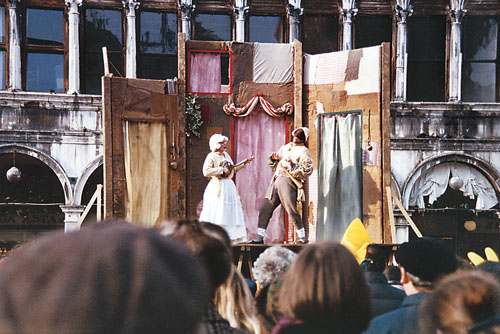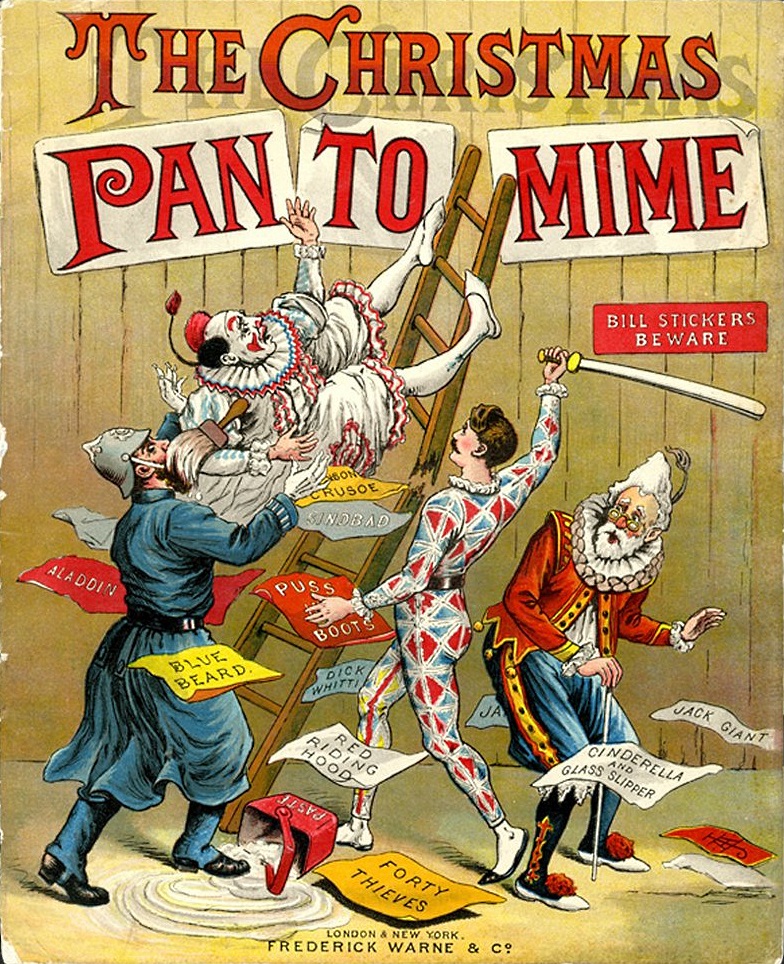|
Pantalone
Pantalone , spelled Pantaloon in English, is one of the most important principal characters found in . With his exceptional greed and status at the top of the social order, Pantalone is "money" in the commedia world. His full name, including family name, is ''Pantalon de' Bisognosi'', Italian for "Pantalone of the Needy".Robert Henke ''Performance and literature in the commedia dell'arte'', Improvisation and characters, Individual roles, pp. 19–24 Character Pantalone originated as part of a master/servant duo and was the original il Magnifico stock character. Carlo Goldoni, in his memoirs, named Pantalone as one of the four primary Commedia dell'Arte characters. Among other things, Pantalone is a character of Venetians; one theory is that his name derives from Saint Pantaleon (''San Pantalone''), a popular saint in Venice. Another theory is that his name derives from Venetian merchants who were called Piantaleoni. While the theories of the St Pantaleone and the lion of St Mark ... [...More Info...] [...Related Items...] OR: [Wikipedia] [Google] [Baidu] |
Zanni
Zanni (), Zani or Zane is a character type of commedia dell'arte best known as an astute servant and a trickster. The Zanni comes from the countryside and is known to be a "dispossessed immigrant worker".Rudlin, John. ''Commedia dell'arte: An Actors Handbook''. London: Routledge, 1994. 67. Print."Immigrant" in Italy at the time of the city-states did not mean someone from outside of Italy but rather someone from outside the city, an itinerant worker. Through time, the Zanni grew to be a popular figure who was first seen in ''commedia'' as early as the 14th century. The English word ''zany'' derives from this person. The longer the nose on the characters mask the more foolish the character. Origin of the name The name ''Zanni'' (as well as ''Zuan'') is a variant of the name ''Gianni'' and was common in the Lombard-Venetian countryside which provided most of the servants to the wealthy nobles and merchants of Venice. In Italian it is specifically a name of someone whose identity i ... [...More Info...] [...Related Items...] OR: [Wikipedia] [Google] [Baidu] |
Commedia Dell'arte
(; ; ) was an early form of professional theatre, originating from Italian theatre, that was popular throughout Europe between the 16th and 18th centuries. It was formerly called Italian comedy in English and is also known as , , and . Characterized by masked "types", was responsible for the rise of actresses such as Isabella Andreini and improvised performances based on sketches or scenarios. A , such as ''The Tooth Puller'', is both scripted and improvised. Characters' entrances and exits are scripted. A special characteristic of is the , a joke or "something foolish or witty", usually well known to the performers and to some extent a scripted routine. Another characteristic of is pantomime, which is mostly used by the character Arlecchino, now better known as Harlequin. The characters of the usually represent fixed social types and stock characters, such as foolish old men, devious servants, or military officers full of false bravado. The characters are exaggerated " ... [...More Info...] [...Related Items...] OR: [Wikipedia] [Google] [Baidu] |
Vecchio Class Characters
''Vecchio'' (; plural ''vecchi'', meaning "old one" or simply "old"), is a category of aged, male characters from the Italian ''commedia dell'arte''. The primary members of this group are Pantalone, Il DottoreRobert Henke ''Performance and literature in the commedia dell'arte'', Improvvisation and characters, Individual roles, pp.19-24 and Il Capitano. Pantalone and Il Dottore are the alter ego of each other, Pantalone being the decadent wealthy merchant, and Il Dottore being the decadent erudite. They are overwhelmingly the antagonists, opposing the love of the ''innamorati''; the comic ending is produced when the ''zanni'' manage to overcome them and unite the lovers. "Vecchio" is the Italian word for "old" (as used in Ponte Vecchio The Ponte Vecchio ("Old Bridge", ) is a medieval stone closed-spandrel segmental arch bridge over the Arno River, in Florence, Italy. The only bridge in Florence spared from destruction during the Second World War, it is noted for the shops bui ... [...More Info...] [...Related Items...] OR: [Wikipedia] [Google] [Baidu] |
Innamorati
''Gli Innamorati'' (, meaning "The Lovers") were stock characters within the theatre style known as commedia dell'arte, who appeared in 16th century Italy. In the plays, everything revolved around the Lovers in some regard. These dramatic and posh characters were present within ''commedia'' plays for the sole purpose of being in love with one another, and moreover, with themselves. These characters move elegantly and smoothly, and their young faces are unmasked unlike other commedia dell'arte characters. Despite facing many obstacles, the Lovers were always united by the end.Eick, JustiCommedia dell'Arte Origins The name ''Innamorati'' is the Italian word for "Lovers".Rudlin, John. ''Commedia dell'Arte, An Actor's Handbook''. Routledge, London, 1994, pp.106 The dramatists of the Italian Renaissance borrowed ideas from early Roman playwrights, such as Plautus and Terence, whom the theater style known as ''commedia erudita'' was inspired by. The "lovers" are the first actor, firs ... [...More Info...] [...Related Items...] OR: [Wikipedia] [Google] [Baidu] |
Saint Pantaleon
Saint Pantaleon ( el, Παντελεήμων, russian: Пантелеи́мон, translit=Panteleímon; "all-compassionate"), counted in the West among the late-medieval Fourteen Holy Helpers and in the East as one of the Holy Unmercenary Healers, was a martyr of Nicomedia in Bithynia during the Diocletianic Persecution of 305 AD. Though there is evidence to suggest that a martyr named Pantaleon existed, some consider the stories of his life and death to be purely legendary. Life of Pantaleon According to the martyrologies, Pantaleon was the son of a rich pagan, Eustorgius of Nicomedia, and had been instructed in Christianity by his Christian mother, Saint Eubula; however, after her death he fell away from the Christian church, while he studied medicine with a renowned physician Euphrosinos; under the patronage of Euphrosinos he became physician to the emperor, Galerius. He was won back to Christianity by Saint Hermolaus (characterized as a bishop of the church at Nicomedi ... [...More Info...] [...Related Items...] OR: [Wikipedia] [Google] [Baidu] |
Harlequinades
''Harlequinade'' is a British comic theatrical genre, defined by the ''Oxford English Dictionary'' as "that part of a pantomime in which the harlequin and clown play the principal parts". It developed in England between the 17th and mid-19th centuries. It was originally a slapstick adaptation or variant of the Commedia dell'arte, which originated in Italy and reached its apogee there in the 16th and 17th centuries. The story of the Harlequinade revolves around a comic incident in the lives of its five main characters: Harlequin, who loves Columbine; Columbine's greedy and foolish father Pantaloon (evolved from the character Pantalone), who tries to separate the lovers in league with the mischievous Clown; and the servant, Pierrot, usually involving chaotic chase scenes with a bumbling policeman. Originally a mime (silent) act with music and stylised dance, the harlequinade later employed some dialogue, but it remained primarily a visual spectacle. Early in its development, it ach ... [...More Info...] [...Related Items...] OR: [Wikipedia] [Google] [Baidu] |
Pants
Trousers (British English), slacks, or pants are an item of clothing worn from the waist to anywhere between the knees and the ankles, covering both legs separately (rather than with cloth extending across both legs as in robes, skirts, and dresses). In the United Kingdom, the word ''pants'' generally means underwear and not trousers. Shorts are similar to trousers, but with legs that come down only to around the area of the knee, higher or lower depending on the style of the garment. To distinguish them from shorts, trousers may be called "long trousers" in certain contexts such as school uniform, where tailored shorts may be called "short trousers" in the UK. The oldest known trousers, dating to the period between the thirteenth and the tenth centuries BC, were found at the Yanghai cemetery in Turpan, Sinkiang ( Tocharia), in present-day western China. Made of wool, the trousers had straight legs and wide crotches and were likely made for horseback riding. In most of Europe, ... [...More Info...] [...Related Items...] OR: [Wikipedia] [Google] [Baidu] |
The Bloody Chamber
''The Bloody Chamber'' (or ''The Bloody Chamber and Other Stories'') is a collection of short fiction by English writer Angela Carter. It was first published in the United Kingdom in 1979 by Gollancz and won the Cheltenham Festival Literary Prize. The stories share a theme of being closely based upon fairytales or folk tales. However, Carter has stated: The collection contains ten stories: "The Bloody Chamber", "The Courtship of Mr Lyon", "The Tiger's Bride", "Puss-in-Boots", "The Erl-King", "The Snow Child", "The Lady of the House of Love", "The Werewolf", "The Company of Wolves" and "Wolf-Alice". The tales vary greatly in length, with the novelette "The Bloody Chamber" being "more than twice the length of any of the other stories, and more than thirty times the length of the shortest vignette "The Snow Child"].". The collection's contents are also reprinted in Carter's ''Burning Your Boats''. Story summaries The stories within ''The Bloody Chamber'' are explicitly ba ... [...More Info...] [...Related Items...] OR: [Wikipedia] [Google] [Baidu] |
Angela Carter
Angela Olive Pearce (formerly Carter, Stalker; 7 May 1940 – 16 February 1992), who published under the name Angela Carter, was an English novelist, short story writer, poet, and journalist, known for her feminist, magical realism, and picaresque works. She is best known for her book'' The Bloody Chamber'', which was published in 1979. In 2008, ''The Times'' ranked Carter tenth in their list of "The 50 greatest British writers since 1945". In 2012, ''Nights at the Circus'' was selected as the best ever winner of the James Tait Black Memorial Prize. Biography Born Angela Olive Stalker in Eastbourne, in 1940, to Sophia Olive (née Farthing; 1905–1969), a cashier at Selfridge's, and journalist Hugh Alexander Stalker (1896–1988), Carter was evacuated as a child to live in Yorkshire with her maternal grandmother. After attending Streatham and Clapham High School, in south London, she began work as a journalist on ''The Croydon Advertiser'', following in her father's footsteps ... [...More Info...] [...Related Items...] OR: [Wikipedia] [Google] [Baidu] |
Breeches
Breeches ( ) are an article of clothing covering the body from the waist down, with separate coverings for each human leg, leg, usually stopping just below the knee, though in some cases reaching to the ankles. Formerly a standard item of Western world, Western men's clothing, they had fallen out of use by the mid-19th century in favour of trousers. Modern athletic garments used for English riding and fencing, although called ''breeches'' or ''britches'', differ from breeches. Etymology ''Breeches'' is a double plural known since c. 1205, from Old English , the plural of "garment for the legs and trunk", from the Indo-European root *bhrg- "break", here apparently used in the sense "divide", "separate", as in Scottish Gaelic briogais ("trousers"), in Breton bragoù ("pants"), in Irish bríste ("trousers") and brycan/brogau in Welsh. Cognate with the Proto-Germanic language, Proto-Germanic word ''*brōk-'', plural ''*brōkiz'', itself most likely from the Proto-Indo-European roo ... [...More Info...] [...Related Items...] OR: [Wikipedia] [Google] [Baidu] |
Shakespeare
William Shakespeare ( 26 April 1564 – 23 April 1616) was an English playwright, poet and actor. He is widely regarded as the greatest writer in the English language and the world's pre-eminent dramatist. He is often called England's national poet and the " Bard of Avon" (or simply "the Bard"). His extant works, including collaborations, consist of some 39 plays, 154 sonnets, three long narrative poems, and a few other verses, some of uncertain authorship. His plays have been translated into every major living language and are performed more often than those of any other playwright. He remains arguably the most influential writer in the English language, and his works continue to be studied and reinterpreted. Shakespeare was born and raised in Stratford-upon-Avon, Warwickshire. At the age of 18, he married Anne Hathaway, with whom he had three children: Susanna Hall, Susanna, and twins Hamnet Shakespeare, Hamnet and Judith Quiney, Judith. Sometime between 1585 and 1592, ... [...More Info...] [...Related Items...] OR: [Wikipedia] [Google] [Baidu] |
SAND Maurice Masques Et Bouffons 06
Sand is a granular material composed of finely divided mineral particles. Sand has various compositions but is defined by its grain size. Sand grains are smaller than gravel and coarser than silt. Sand can also refer to a textural class of soil or soil type; i.e., a soil containing more than 85 percent sand-sized particles by mass. The composition of sand varies, depending on the local rock sources and conditions, but the most common constituent of sand in inland continental settings and non-tropical coastal settings is silica (silicon dioxide, or SiO2), usually in the form of quartz. Calcium carbonate is the second most common type of sand, for example, aragonite, which has mostly been created, over the past 500million years, by various forms of life, like coral and shellfish. For example, it is the primary form of sand apparent in areas where reefs have dominated the ecosystem for millions of years like the Caribbean. Somewhat more rarely, sand may be composed of calcium ... [...More Info...] [...Related Items...] OR: [Wikipedia] [Google] [Baidu] |




_by_shakko.jpg)



